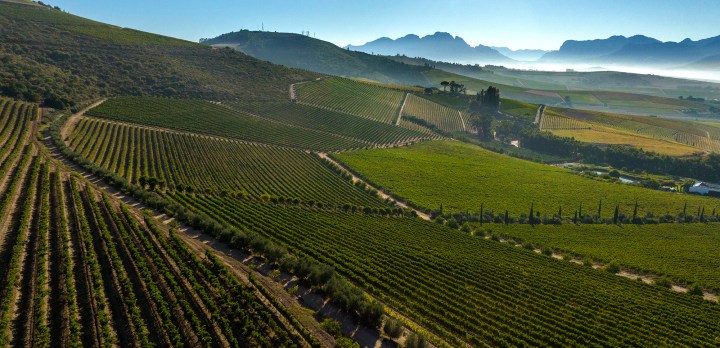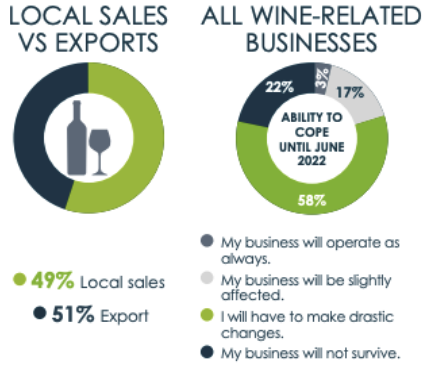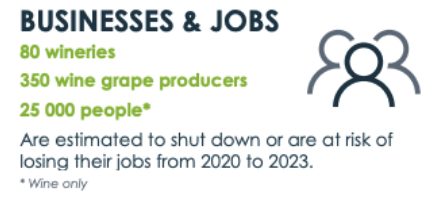GRAPE EXPECTATIONS
New brooms sweep clean in SA wine industry as investors see only opportunities

International investors are pumping money into South Africa’s stressed winelands in a wave of acquisitions that’s sparking relief for the industry.
South African wine estates are being scooped up, with a number of prestigious properties – including Uitkyk, Villiera and Kleine Zalze – acquired by international investors over the past few months.
These acquisitions add to an already long list of formerly locally owned properties bought with foreign money: Alto, Ernie Els, Warwick, Le Bonheur, Ken Forrester, L’Avenir, Stellenbosch Vineyards, Neethlingshof and others.
It’s not a new phenomenon or even particularly unique to SA: Wealthy foreigners, especially from Germany and France, have invested in wine properties for decades.
In France, foreign investors from the US, UK, China, Japan and elsewhere have secured some of the most prestigious estates around Bordeaux, deeming a property in that country’s wine regions to be the ultimate status symbol.
Visit Daily Maverick’s home page for more news, analysis and investigations
Over the past decade, Chinese investors acquired about 170 chateaus, or about 2% of all Bordeaux properties. Chinese investors have also bought nearly 150 wineries in Bordeaux since 2008, giving their new acquisitions names like “Lapin impérial” (Imperial Rabbit), “Lapin d’or” [Golden Rabbit] or “Antilope tibétaine” (Tibetan Antelope). That trend has eased off and some of the wine estates are now falling into financial ruin, reports Le Monde.
In the Land of the Long White Cloud, American buyers, in particular, have sniffed out properties: between 2010 and 2021, almost 180,000 hectares of New Zealand’s farming land was either purchased or leased by foreigners.
Many of New Zealand’s larger labels are now owned offshore, including Constellation Brands (US); Treasury Wine Estates (Australia); Pernod Ricard, the world’s second-largest wine and spirits seller (France), and Foley Wines (also the US).
SA’s currency discount
Foreign ownership of wine estates is not as widespread internationally as it is in SA, because the currency discount works in the investors’ favour.
Roland Peens, CEO of Wine Business Advisors, explained: “Frankly, these assets are just so cheap compared to other regions, and that’s what makes them so attractive.”
Peens, who is also Strauss & Co’s wine specialist, said investors are backing the SA wine sector for the long haul. It takes a long time to institute new planting strategies, which means the wines that will result from a sale are only likely to hit the market in several years.
“These are very, very long-term investments.”
And many SA estates are struggling: vineyards are becoming neglected as they’re too expensive to farm, and the wine volumes that were taken up by big players like Distell are not as high as previously.
“The supply in the market has come down 20% over the past 20 years. There is a real declining demand for entry-level wine.”
On the flipside, there is an increasing demand for fine wine. SA has about 100 producers of premium wine – their products fetch lofty prices; they operate on good margins and they’re able to invest in their farms.
Luxury segment
Peens, who prices secondary market wines for investors at Strauss & Co, said SA arguably hasn’t yet reached investment grade in terms of wine, but it’s a swelling category.
“We don’t trade in international markets as an investment. And that’s going to change slowly. We only started trading in the secondary market at Wine Cellar about 10 years ago, and at Strauss, only five years ago. That market needs to mature more and there’s a lot of work ahead.”
International owners have a culture and understanding of how to handle luxury wine assets and develop them, he said. Globally, the luxury market has boomed and wine has been growing at 6%-plus per year for decades.
The luxury segment is a great business to be in, he added, saying that international owners have a culture and understanding of how to handle wine assets and develop them.
“South Africans seem to be too scared. You know, we see all the problems and we are too risk-averse. But I think the stronger hands of the European owners understand farming and the wine industry better. It’s a much longer-term type of investment.
“But, generally, the rest are just trying to survive,” Peens said.
Export volumes down
The sector is certainly being squeezed: Wines of South Africa’s (Wosa) data shows wine export volumes were down by 5% and the value of exports declined by 2.4% to R9.9-billion (down from R10.2-billion in 2021).
In total, 368.8 million litres of wine left SA shores last year, which is about 20 million litres less than in 2021. The decline is attributed to shipping constraints at Cape Town harbour due to industrial action and adverse weather conditions, which prevented ships from docking during April 2022.
The total price per litre increased by 2.2%, mainly supported by the 5.3% increase in bulk. Bulk wine exports equate to 62% of total export volumes, but in terms of value contribution, packaged wine is by far the value leader at 77%.
Wosa’s SA Wine Industry Economic Report from 2022, sourced from wine producer body Vinpro and the SA Wine Industry Information and Systems data, suggests many wine businesses are in trouble: only 3% of respondents said their business will operate as usual; 58% said they will have to make drastic changes; 17% said they need to make changes; and 22% said their business will not survive.

Producers are also heavily reliant on exports, as 49% said they sold their wines to local consumers.
Eighty wineries are expected to close this year, putting 25,000 jobs at risk.
 Celebrated wine judge and writer Michael Fridjhon noted in Wine magazine last week that the figures are “frankly chilling”.
Celebrated wine judge and writer Michael Fridjhon noted in Wine magazine last week that the figures are “frankly chilling”.
“Only 9% [of wine farms] are making enough money to replace vineyards as they age (or succumb to sickness). Fifty percent are breaking even on cash flow – but without the surplus necessary to replant. Three percent are cash-neutral while 38% are actually bleeding money.
“Sales are not growing, and while exports seem solid, two-thirds of the wine that is leaving our shores is bulk wine earning little profit.”
The UK, SA’s biggest wine export market, has grown by 5% in volume, while the Chinese market, which previously showed exponential growth for SA wine, has slowed due to the extended Covid lockdown.
SA’s second-largest market, Germany, declined by 17% in value and 9% in volume, mostly due to rising inflation in that country, and an increase in living costs.
Foreign investment and upgrading
Fridjhon said foreign owners come into the country and use hard currency to invest and upgrade their farms. Citing Glenelly, which was previously a run-down fruit farm in Idas Valley, the “Wine Wizard” said owner May de Lencquesaing, the former owner of the Château Pichon Longueville Comtesse de Lalande in Bordeaux, bought the property in 2003 at the age of 78, planted vineyards and spent about R100-million on the cellar.
“Now, it’s a spectacular property. All of this has happened in the last 20 years. All of this is done in euros rather than in rands. All of this is, in fact, to the good of the industry. I can’t think of a single reason why it shouldn’t be encouraged.”
As for what it means for local winemakers, he cited the example of the revolution in winemaking, triggered by dynamic independent producers who ventured into areas like the Swartland, contracted with growers, bought their fruit instead of owning the land and produced some of SA’s most high-profile yet low-volume wines.
On Tuesday, the leading international wine trade fair, ProWein, wrapped up in Düsseldorf.
Ahead of the event, Wosa CEO Siobhan Thompson said for the first time in several years, the industry was due to have a major presence at the fair. It’s vital exposure for the industry after years of battering by Covid, rolling blackouts and industrial action.
“Our producers can’t wait to hop on planes and have face-to-face meetings with importers and buyers again. We expect 2023 to be a very successful year for South African wine exports.” BM/DM

















 Become an Insider
Become an Insider
If the French are flogging their wine lands to the Chinese and purchasing in South Africa, perhaps this should be telling us something! Droughts, wildfires and now flooding in California has also given SA the edge as a viable, cost effective alternative.
Climate change is a long term challenge to wine producers and is happening quicker than we thought ….who would have guessed that Britain would become a viable wine producer? But there it is.
The French and Germans are hedging their bets once again, 300 years after their first foray into wine farming in South Africa…… and good luck to them!